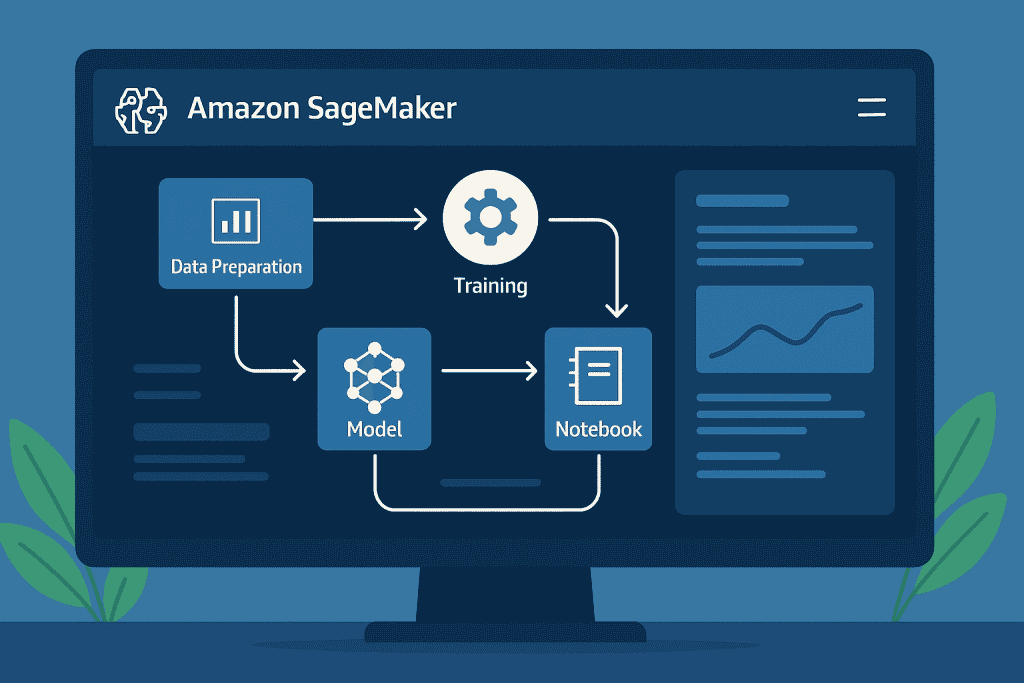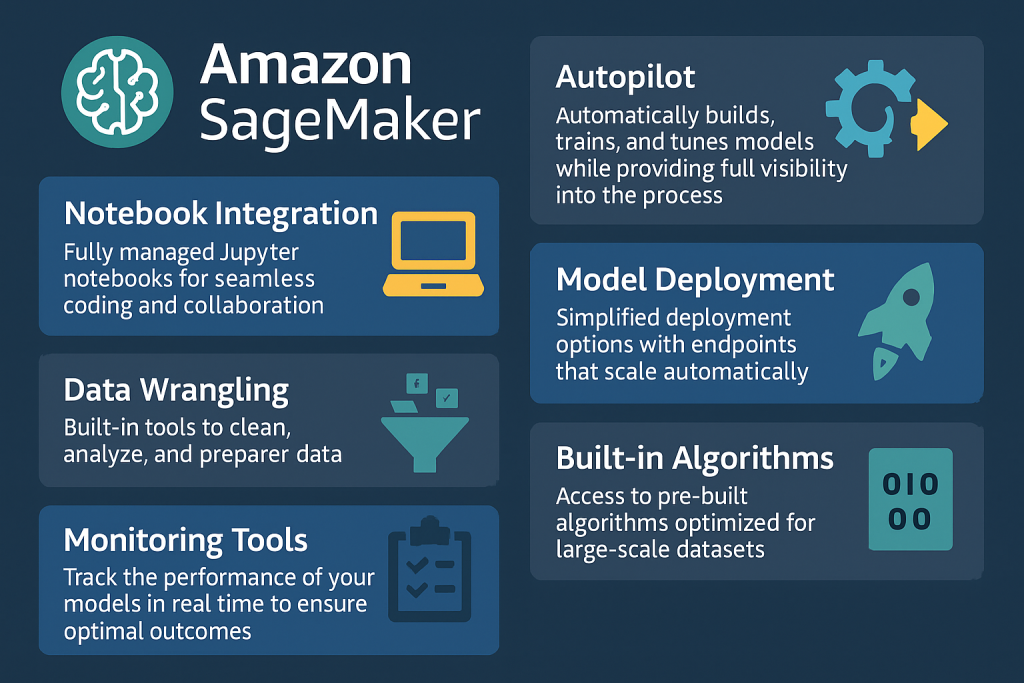
Amazon SageMaker is a game-changer in the world of machine learning. With its comprehensive suite of tools, it simplifies the complex process of building, training, and deploying machine learning models. Whether you’re a data scientist or a developer, SageMaker provides the innovation and flexibility needed to streamline your workflows.
In this review, I’ll break down its key features, dive into its strengths and weaknesses, and share how it stacks up against other platforms. Whether you’re new to machine learning or a seasoned professional, you’ll find everything you need to know about SageMaker in this guide.
Overview of Amazon SageMaker
Amazon SageMaker is a fully managed machine learning service designed to accelerate the process of developing and deploying AI models. It’s part of the AWS ecosystem, which means it integrates seamlessly with other AWS services to provide end-to-end support for machine learning workflows.
Amazon SageMaker offers an array of features designed to simplify machine learning workflows. Its ease-of-use shines through intuitive interfaces and built-in tools for data preparation, model training, and deployment, making it accessible even for beginners. The platform is highly scalable, allowing resources to expand or contract based on the specific needs of your project. With broad compatibility, it supports popular machine learning frameworks like TensorFlow and PyTorch, ensuring flexibility for developers. Moreover, its cost efficiency is a major advantage, featuring a pay-as-you-go pricing model that eliminates the need for upfront infrastructure investments.
In short, SageMaker empowers organizations to leverage advanced machine learning capabilities without needing extensive expertise or resources.
Key Features of Amazon SageMaker

Amazon SageMaker packs a variety of powerful tools that cater to different stages of the machine learning pipeline, combining advanced technology with user-friendly solutions. Below are some of its standout features:
- Notebook Integration: Fully managed Jupyter notebooks for seamless coding and collaboration.
- Autopilot: Automatically builds, trains, and tunes models while providing full visibility into the process.
- Data Wrangling: Built-in tools to clean, analyze, and prepare data.
- Model Deployment: Simplified deployment options with endpoints that scale automatically.
- Monitoring Tools: Track the performance of your models in real time to ensure optimal outcomes.
- Built-in Algorithms: Access to pre-built algorithms optimized for large-scale datasets.
Each feature works together to create an efficient and user-friendly environment for machine learning development.
Pros and Cons
| Pros | Cons |
|---|---|
| Fully managed service with minimal setup. | May require AWS ecosystem knowledge. |
| Supports multiple ML frameworks and tools. | Pricing can get expensive for large projects. |
| Offers automation for training and tuning. | Limited offline support for edge devices. |
| Scalable infrastructure for growing projects. | Learning curve for beginners. |
In-Depth Analysis of Amazon SageMaker

Performance
Amazon SageMaker delivers impressive performance by optimizing compute resources to speed up model training. Its distributed training capabilities allow users to process large-scale datasets quickly, cutting down the time required for tasks that would otherwise take much longer. This makes it a reliable choice for demanding machine learning projects that need to handle massive amounts of data efficiently.
Usability
When it comes to usability, SageMaker excels with its intuitive design, making it accessible even for beginners. SageMaker Studio, the platform’s all-in-one integrated development environment (IDE), simplifies the machine learning process by bringing everything you need into one place. You can write code, test it, and debug your models without constantly switching between tools, saving both time and effort.
Integration with AWS Ecosystem
SageMaker’s seamless integration with the AWS ecosystem further enhances its appeal. It works effortlessly with services like Amazon S3 for storage, Lambda for event-driven computing, and EC2 for scalable cloud resources. This integration eliminates the need for manual data transfers, streamlining the entire workflow. For businesses already leveraging AWS, SageMaker fits right in, creating a cohesive and efficient machine learning environment.
Security and Compliance
Security is crucial for any machine learning platform, especially for industries like healthcare, finance, or e-commerce, which handle sensitive data. SageMaker operates within the robust AWS security framework, offering encryption during data transit and storage. It also complies with standards like GDPR, HIPAA, and ISO certifications, ensuring that businesses can use the platform without worrying about compliance risks. For companies in regulated industries, these features make SageMaker a strong contender.
Cost and Pricing Model
SageMaker’s pay-as-you-go pricing makes it accessible for businesses of all sizes. However, larger-scale projects with frequent usage may find costs adding up quickly. Comparing its pricing structure to similar platforms like Google Vertex AI or Microsoft Azure ML would highlight its cost efficiency. Additionally, features like SageMaker Savings Plans or reserved capacity could provide options for long-term savings.
Customization and Flexibility
SageMaker’s support for multiple frameworks like TensorFlow, PyTorch, and MXNet makes it highly flexible. Additionally, its ability to support custom algorithms and deploy models in custom containers provides businesses with the tools they need to tailor solutions to specific use cases. This flexibility appeals to companies that need specialized machine learning models or pipelines.
Amazon SageMaker Comparison
Amazon SageMaker stands out with its automation capabilities and integration with the AWS ecosystem. Here’s a quick comparison with similar platforms:
| Feature | Amazon SageMaker | Google Vertex AI | Microsoft Azure ML |
|---|---|---|---|
| Automation | Advanced (SageMaker Autopilot) | Basic tuning tools | Intermediate tools |
| Integration | Seamless with AWS | Strong with Google Cloud | Solid with Microsoft Azure |
| Cost | Pay-as-you-go | Flexible plans | Pay-as-you-go |
| Ease of Use | Beginner-friendly | Moderate | Beginner-friendly |
Conclusion
Amazon SageMaker is a robust and reliable tool for businesses and individuals looking to simplify their machine learning workflows. Its seamless integration with AWS, automation capabilities, and scalability make it a top contender in the AI space.
If you’re already part of the AWS ecosystem, SageMaker is worth considering. While it has a learning curve for beginners, the value it provides far outweighs the drawbacks.
Amazon SageMaker Rating
Based on its features, performance, and usability, Amazon SageMaker scores 4.5/5 stars. It excels in scalability and automation, but its pricing may not suit small projects.
FAQ
What makes Amazon SageMaker unique?
Amazon SageMaker stands out due to its comprehensive automation tools, scalability, and seamless integration with the AWS ecosystem. It’s ideal for businesses looking to streamline machine learning workflows.
Can beginners use Amazon SageMaker?
Yes! While SageMaker has a learning curve, its user-friendly interface and detailed documentation make it accessible to beginners interested in machine learning.
How does Amazon SageMaker compare with other platforms?
Amazon SageMaker excels in automation and AWS integration compared to platforms like Google Vertex AI and Microsoft Azure ML. However, pricing can be higher for large-scale projects.
Resources
- Steps to Cloud. What is AWS SageMaker?
- AWS. Amazon SageMaker Overview
- Medium. Is SageMaker Worth It?
- G2. Amazon SageMaker Reviews
- TrustRadius. Amazon SageMaker Reviews
